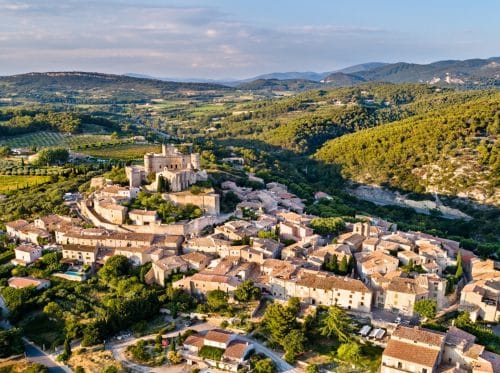The Ventoux – Biosphere and Regional National Park
The highest peak in the Vaucluse, Mont Ventoux, rising above Provence, towers over the surrounding plain and hills and clearly draws people’s eyes and attention. It truly makes us dream with its wild summit that defies the wind, its hillsides rich in crops, its lavender and its vines, its dry stone walls and its picturesque villages. Like us, you will never tire of it.
This mountain presents both rich vegetation with its vast forests and its great variety of plants as well as an abundant mineral landscape all around its 1,910-meter summit. Here the vegetation yields to a desert of limestone rocks which give it, on the south side, its particular white color that earned it the nickname “the Little Kilimanjaro of Provence”. It is true that, seen from the plain, one might believe it is capped in snow all year round, thanks to this seemingly lunar terrain.
From this grandiose terrace, you must first close your eyes and breathe. The scent of Provence is in the air! The region is adorned with azure blue from the first days of lovely weather, and offers inimitable fragrances, with landscapes to die for. In clear weather, we discover an exceptional 360-degree panorama over the entire Alps range, the Massif Central and the Cévennes, the lower Rhône Valley and Avignon, the Camargue, the Crau plain and even the Mediterranean Sea.
In fact, this mountain range shares the same climate as the Southern Alps, of which it is the westernmost extension. From a Mediterranean climate in the south, it shifts as the altitude increases towards a temperate then finally continental mountain climate at the summit. Several worlds in a single place. Captivating. This combination lends the area its rich flora with more than 1,000 species of plants at five different levels of vegetation, as well as its diverse fauna, in particular with more than 100 species of birds.
The flora of the Ventoux
On its lower slopes and at the foot of the Ventoux, the vegetation is typical of the Mediterranean climate, with a majority of evergreen trees and shrubs. Here we find Holm oak, Kermes oak, Atlas cedar (the same as in the Luberon cedar forest, both from the same reforestation campaign), pines including Aleppo pine and some olive groves or lavender fields on the foothills. In areas where the trees are less dense, the garrigue scrubland offers colorful, fragrant vegetation including dwarf iris, thyme, rosemary, honeysuckle and much more.
Then, a little higher up, the groves of Holm oak gradually yield to white oak (whose leaves turn golden yellow in the fall), to undergrowth of plentiful boxwood (whose foliage turns red in the fall), and to spike lavender and juniper. In May, there is an explosion of color with the pink flowers of rock soapwort, the yellow flowers of laburnum and broom and the blue flowers of Montpellier aphyllantes. In the less dense woods, we can find orchids.
The unique, diverse mountain vegetation offers the Ventoux area most of its floral variety. Forests of beeches, fir trees, Scots pines and, above all, moors and screes. The cool mountain climate also allows several varieties of orchids to bloom, including the pale-flowered orchid (rare, found only here in the Vaucluse area), sprinkled about the Ventoux hillsides.
The summit is a paradise for small plants resistant to wind and cold, with colors that protect them from ultraviolet rays. The star plant at the peak is certainly the candytuft. In the middle of what appears to be a stone desert hide a wide variety of plant species that thrive in the mountains, some of which are extremely rare or even endemic. Countless varieties to look at, contemplate and – most importantly – definitely not pick!
The fauna of the Ventoux
Large hooved animals came back to the area after the slopes of Mont Ventoux were reforested. In addition to wild boar, deer have now perfectly taken to the hillsides (in the autumn, you can even sleep outside amidst the trees to hear the deer bellowing at night. An astonishing experience. Inquire at the local tourist offices). The area is also once again home to chamois, mouflons and roe deer,as well as to hares, rabbits, foxes and badgers.
As for bird fauna, the area is home to 120 species of raptors and nesting birds, some of which are rare such as the wood grouse, Tengmalm’s owl (originally from the large northern boreal forests, it came to the northern flank of the Ventoux in the 1960s) or the peregrine falcon. The most emblematic raptor of Ventoux is undoubtedly the short-toed snake eagle, a migratory bird that feeds only on reptiles, including Orsini’s viper, a small, harmless, very fearful snake that is found in roughly a dozen locations in France, including the Mont Serein area of Mont Ventoux.
In Aurel, the “Large Fauna of Ventoux” discovery trail allows you to explore forest wildlife and enjoy stunning views of Lure Mountain and the Sault countryside, via a 2-hour walk. The trail is equipped with a picnic area and observatories in the trees, and can also be walked at night.
And what about environmental protection?
It is important to note that the Ventoux area benefits from 2 important environmental labels:
First, the Ventoux is recognized as one of the 14 Biospheres of France. This label, granted to an area by UNESCO, recognizes the capacity of its population to live in an exceptional environment while protecting it.
With its many different natural environments, Mont Ventoux offers a setting favorable to a varied population of flora and fauna. Mixing coniferous and deciduous trees, rock outcrops and thick cover, it is a one-of-a-kind ecological niche, a small area where many species are concentrated.
Click here to find out more here: bit.ly/reservedebisophere-MontVentoux
In addition to the biosphere reserve, the Ventoux features a number of protected zones, such as the Natura 2000 areas, which include the Nesque gorges, the Toulourenc valley, and the summit and ridges.
In line with the protection of nature involving local populations, in 2020, Mont Ventoux was named the 9th Regional Natural Park in France’s South region.
The area, where Malaucène and Prieuré La Madelène are located, features a wide variety of landscapes and environments, with 58% natural lands and 33% agricultural lands.
Such recognition will enable this area and its population’s lifestyle to be protected. “This gem, with a vast treasure of flora and fauna, deserved to benefit from increased surveillance in order to sustainably protect this earthly paradise in the Provence-Alpes-Côte d’Azur region”.
For more information, visit the Park’s website: bit.ly/ParcduVentoux
Strolls and hikes in the Ventoux
The Ventoux area is a heaven for athletes ready to take on the personal and physical challenge of its ascent, as well as a unique, very popular place for hiking, with many circle trails of all levels that allow you to escape into still wild, unspoiled nature.
On the other hand, always keep in mind that there is no shortage of stories from people who have had to brave the area’s extreme conditions. The myth of the “Giant of Provence” also stems from the fear it inspires, because up there, the weather can often be quite harsh. Its altitude causes temperature differences with the plain and sometimes, even in the middle of summer, howling gales, fog or heavy rains can act as spoilers, making the excursion “memorable” to say the least!
So, we highly recommend to those venturing up to discover Ventoux to check the weather beforehand and not to forget a jacket or, better still, a windbreaker. It can get really chilly up at that altitude! Even in Provence. There is also a saying that reminds us of this: “When the Ventoux is wearing its hat, if it isn’t raining now, it soon will be”. The mountain remains a very important indicator of the coming weather for the local population.
Close-up on two one-of-a-kind ascents
In the footsteps of Petrarque
The first ascent of Mont Ventoux on record of was that of the Italian poet Petrarque, a native of Tuscany (and crowned “King of the Poets” in 1340, when he was still alive) who decided to settle in Fontaine-de-Vaucluse in order to stay near his love, Laura de Noves.
This love remained platonic, as she was already married. Yet, he made her his muse and dedicated a book of 366 poems called Canzionere (‘The Singer’) to her and the Fountain. He returned to Italy permanently upon the death of Laura, swept away by the plague in 1348.
In 1335, he reached the summit of the “Giant of Provence”, via the more challenging slope as he started from Malaucène and took the northern route. In a letter to the monk Dionigi Da Borgo San Sepolcro, he describes the sea of clouds rolling at his feet, the struggle between light and darkness, and the sublime harshness of these visions.
The nighttime ascent
What a memorable experience! Throughout the summer, guides offer to take you on a nighttime ascent of the “Bald Mountain” (another of its nicknames), culminating with a spectacular view of the sunrise. On the menu: a 12-km climb through the forest and the stone desert, a 1,400-meter elevation gain and a good 5 hours of walking. The descent is just as magical. You can inquire about this excursion at the Ventoux-Provence Tourist Office.
Here, you can find info on the top 10 strolls and hikes in the Ventoux area: bit.ly/randos-Ventoux
The local roads are also ideal for those who love motorcycling. But this is another subject we will get back to in an upcoming post.
We consider it a true privilege to live here, in Malaucène, at the foot of Mont Ventoux. A privilege that we just had to share with you a little: it will be our great pleasure to welcome you for an undoubtedly revitalizing stay at Le Prieuré La Madelène.



